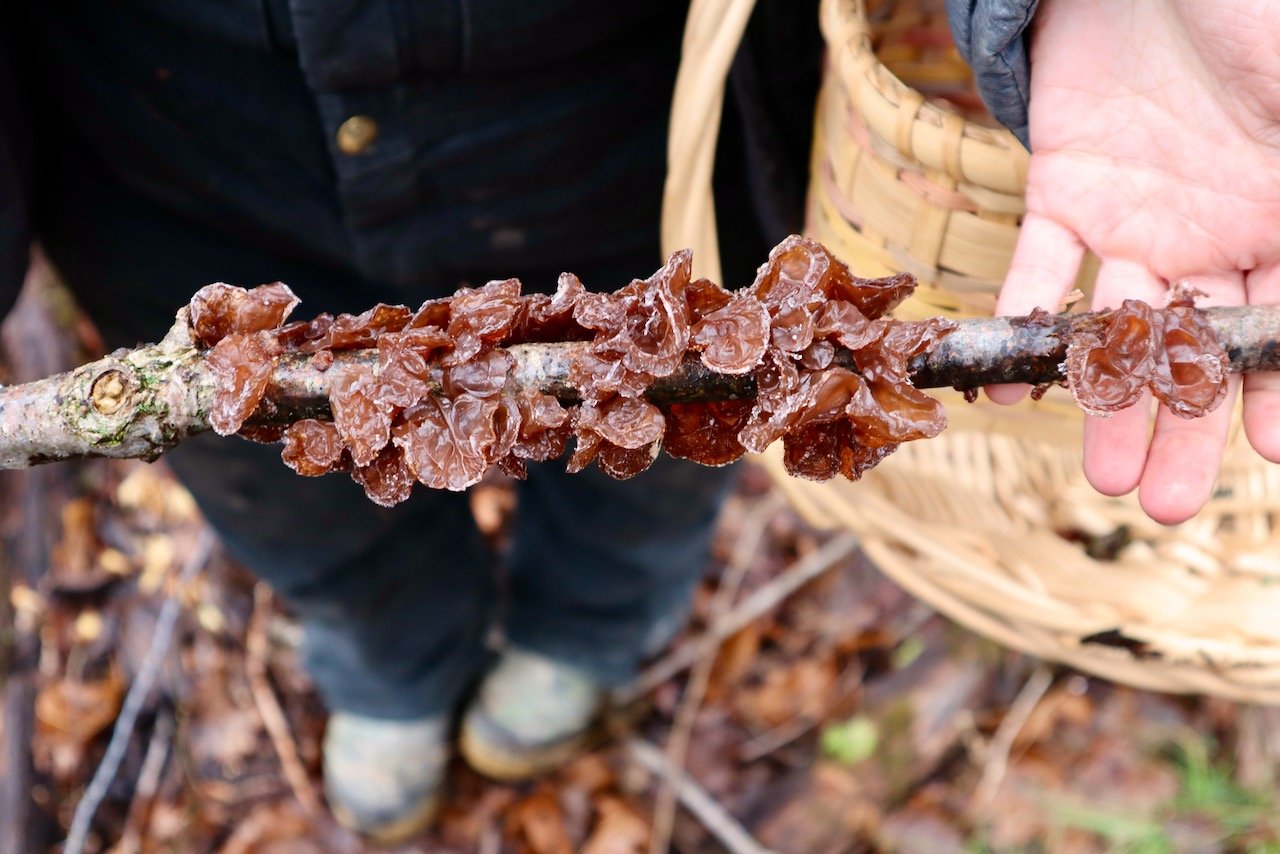Foraging Fools
written by Donna Hecker & photography by Talitha Schroeder
Let’s go foraging, she said. It’ll be fun, she said. Not so fast, said February. A week that began with balmy temps and sunny skies had deteriorated into freezing fog and leaden clouds by the time Friday rolled around.
And yet, as proof positive that life goes on even in the depths of winter, our intrepid little group still found a basketful or two of edible, if questionably tasty, foodstuffs.
Our guide was Storey Slone, a former Holly Hill staffer, now a farmer and enthusiastic forager.
Storey Slone showing off wild rose hips
Storey grew up exploring plants with her dad and studied sustainable land management at Sterling College in Vermont. She’s starting a new job with Grow Appalachia and Berea College as a small farm adviser. First though, she spent a very chilly morning trooping around with us in Georgetown’s Veterans Memorial Wildlife Area.
Squeezed up against northbound I-75, with a looping playlist of traffic sounds, the partially wooded park looked a little sketchy to start. But once we got past the derelict farm buildings and out of sight and sound of the interstate, things improved and we walked away with a pretty good haul.
To wit: hickory bark; hickory nuts; walnuts; spicebush berry; wild rose hips; three types of fungi ~ witch’s butter, amber jelly roll and turkey tail; wild onions; chickweed; cleavers; garlic mustard; wintercress.
The spicebush berry is a dead ringer for allspice, which we know as a West Indian import. The shagbark hickory bark can be boiled and then made into a syrup. Witch’s butter is a strange little fungus: some believe it has medicinal properties, especially for respiratory ailments and indeed, it’s been described as imparting cooling sensations, not unlike Vicks VapoRub.
Old cookbooks used to prescribe spring tonics for restoring digestive systems depleted of vitamins during the winter. Any of the greens we found would be perfect for tossing into the soup pot.
Storey assured us that, with a little more time, we’d have found pine needles, spruce tips, cattail roots, acorns, maple seeds, beechnuts and burdock. And went on to fantasize about sumac, wild berries and grapes, sassafras, cresses and more mushrooms ~ all to be had for the taking with the arrival of warmer weather.
Foraging seems exotic now, but as kids we chewed on sour grass; sucked honeysuckle nectar; hammered walnuts. We were foraging, which has a long proud history in Kentucky. We knew a state trooper from the eastern part of the state, once assigned to the governor’s mansion. He sang the praises of “dry land fish”, soaked, breaded and fried. Morels by any other name, and the inspiration for Irvine, Ky.’s yearly Mountain Mushroom Festival, held the last weekend in April.
When we asked around for guides willing to go out with us, the inquiry sparked a flood of comments and memories. One friend likes to pick dandelion greens and pokeweed in her yard. Our former sous chef Lisa Laufer gathered violets by the handful on the grounds of Holly Hill Inn. We remembered picking wild berries by the gallon; a market vendor who sold chestnuts scavenged along the river, a mom staking out a wild asparagus patch every year.
Storey forages because it’s a “use of resources that come at no cost, are abundant, (and) require mindfulness and intention to harvest and prepare.” She goes on to explain how many foraged plants “were extremely valuable both economically and culturally to communities, (the way) ginseng, goldenseal and cohosh still are to the Appalachian region today. Preparing wild- harvested products is a labor of love that connects you to the natural world and reminds us to be thankful for the things that are often invisible and yet bountiful in our daily lives.”
Amber Jelly Roll found on our excursion
She reminds us that we can forage anywhere. Obviously, the best places are those with less human contact because they’ll be better protected and produce a higher range of diversity. But even in the city, you’ll come across abandoned fruit trees, wild passionfruit, ginkgo biloba nuts. As for the uses of your finds, Storey says they’re endless. She makes salves, jellies, syrups, teas, even natural dyes and tinctures.
Spring is almost here and the ephemerals are coming. Every year we anticipate the arrival of the Spring Beauties which blanket our lawn at Holly Hill Inn. Perhaps this spring they’ll adorn our salads also. Maybe we’ll find some poke to stew and we know there will be violets to crystallize. We hope you’ll forage, too ~ in your backyard, on a city street, in a park whether urban or not ~ and that you’ll find your own treasures for the taking.
Ready to venture out? Here’s a list of helpful guides you should be able to find at your local library:
Dandelion Hunter: Foraging the Urban Wilderness by Rebecca Lerner
Backyard Foraging by Ellen Zachos
Ugly Little Greens by Mia Wasilevich
Roots of Healing by Deb Soule
Wildflowers of Tennessee, the Ohio Valley and the Southern Appalachians by Dennis Horn
Stalking the Wild Asparagus by Euell Gibbons
© 2022, Holly Hill Inn/Ilex Summit, LLC and its affiliates, All Rights Reserved
Related Content
Earth Apples and Shrooms
The beauty of this dish is that you can make it with whatever is fresh and in season locally; this is what we recently found at the Lexington Farmers Market. Measure with your heart and based on your audience. Cooking for yourself? Maybe two potatoes, a handful of mushrooms and a fried local egg on top for a great meal. Cooking for a group? Go for a couple pounds of potatoes, more mushrooms and serve it as a side!









